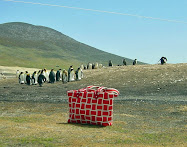
Robert Harling was brought up in Brighton by a relative after being orphaned at a young age. This stylish seaside resort was the perfect environment for a young flaneur with a discerning eye, browsing the famed antique shops of The Lanes and internalising the aesthetic of its splendid Regency architecture. He also loved the sea and was attracted to the pleasure boats pulled up on the shingle, fascinated by their names picked out in decorative script. These no doubt had some bearing on his abiding interest in lettering and typography.
 A Christmas card designed by Robert Harling. In the mid-1940s he and James Shand published Alphabet and Image, a journal of graphics and typography.
A Christmas card designed by Robert Harling. In the mid-1940s he and James Shand published Alphabet and Image, a journal of graphics and typography.Harling's daughter in a charming piece about her late father (World of Interiors May 2009) remembers that he and his wife Phoebe would generally hold their lively dinner parties midweek because Friday evenings and Saturdays were spent at The Sunday Times both designing the news pages and as architectural correspondent. He spent four days a week as editor of House & Garden from 1957 to 1993. Harling must have had extraordinary energy because he was never happier than when he was designing and beautifying houses.
 Robert and Phoebe started married life in a Georgian mill house in Suffolk but moved to an 18th C Sussex rectory called The Glebe House in 1952. He immediately set about restoring its original purity by demolishing an attic floor and mansard roof added by a Victorian rector to house his numerous children and servants.
Robert and Phoebe started married life in a Georgian mill house in Suffolk but moved to an 18th C Sussex rectory called The Glebe House in 1952. He immediately set about restoring its original purity by demolishing an attic floor and mansard roof added by a Victorian rector to house his numerous children and servants. The wide hall, originally built to accommodate waiting parishioners, was furnished with black and white marble tiles that Phoebe bought at a Suffolk auction with no expense spared; and in the 1960s an ochre/greeny blue Puginesque Gothic wallpaper was installed. A set of ten birch Regency dining chairs were bought with an inheritance from Ian Fleming, creator of James Bond, and a fine Biedermeier bow-fronted coat cupboard came from Rupert Cavendish's shop on the King's Road.
The wide hall, originally built to accommodate waiting parishioners, was furnished with black and white marble tiles that Phoebe bought at a Suffolk auction with no expense spared; and in the 1960s an ochre/greeny blue Puginesque Gothic wallpaper was installed. A set of ten birch Regency dining chairs were bought with an inheritance from Ian Fleming, creator of James Bond, and a fine Biedermeier bow-fronted coat cupboard came from Rupert Cavendish's shop on the King's Road.
The sitting-room decor has remained unchanged since 1953. Yellow Regency-style 'Medallion' wallpaper from Cole & Son is in exuberant contrast with the cherry-red chintz and ochre curtains. The chandelier of turquoise glass was added in the 60s, the result of an afternoon's stroll down Mount St.
 A gold-on-gold paper in the Harlings' bedroom gave the room a lustrous glow in the evening sun. The curtain fabric, a wool toile, dates from 1953. A decade later the swags and tails and the carved and gilded trim were added.
A gold-on-gold paper in the Harlings' bedroom gave the room a lustrous glow in the evening sun. The curtain fabric, a wool toile, dates from 1953. A decade later the swags and tails and the carved and gilded trim were added.
A 19th C bedcover, formed from tiny gathered lawn rosettes and on the chest a pair of green obelisks flanked by a quartet of 17th C pietra dura architectureal landscapes.
 I love this image for what looks like an Edward Bawden pelican along with a collection of prints very reflective of Harling's era and enthusiasms. Below: over the Aga is a print by Eric Ravilious (see my earlier post), a contemporary of Bawden. These were quintessentially English artists and illustrators of the early 20th C and I am crazy about them. Edward Bawden designed the wrought iron bench in my first image.
I love this image for what looks like an Edward Bawden pelican along with a collection of prints very reflective of Harling's era and enthusiasms. Below: over the Aga is a print by Eric Ravilious (see my earlier post), a contemporary of Bawden. These were quintessentially English artists and illustrators of the early 20th C and I am crazy about them. Edward Bawden designed the wrought iron bench in my first image.
Robert Harling died in July 2008 at the age of 98. He had a distinguished wartime career in the Royal Navy being in charge of a whaler at Dunkirk, serving in the convoys and getting involved in Naval Intelligence where he worked for Ian Fleming. He launched a series of ten interior design books under the auspices of House & Garden, wrote novels and a memoir entitled Amateur Sailor. What an extraordinary life. I would love to have met him.
The Glebe House's contents will be auctioned by Christie's South Kensington on 9 September.
 As drawn by Nicholas Bentley, Harling was a natty dresser renowned for his drainpipe trousers
As drawn by Nicholas Bentley, Harling was a natty dresser renowned for his drainpipe trousersAll images from World of Interiors May 2009 Text drawn from Amanda Harling's article and Robert Harling's obituary in The Independent 8 July 2008




































I want those Green obelix's! That should be a fun sale at Christies.
ReplyDeleteMarvelous post.
ReplyDeleteIt's good to be reminded that there were, once upon a time, magazine editors who actually liked Decoration.
Toby this is an insight I wasn't aware of, albeit a little wry! thankyou.
ReplyDelete